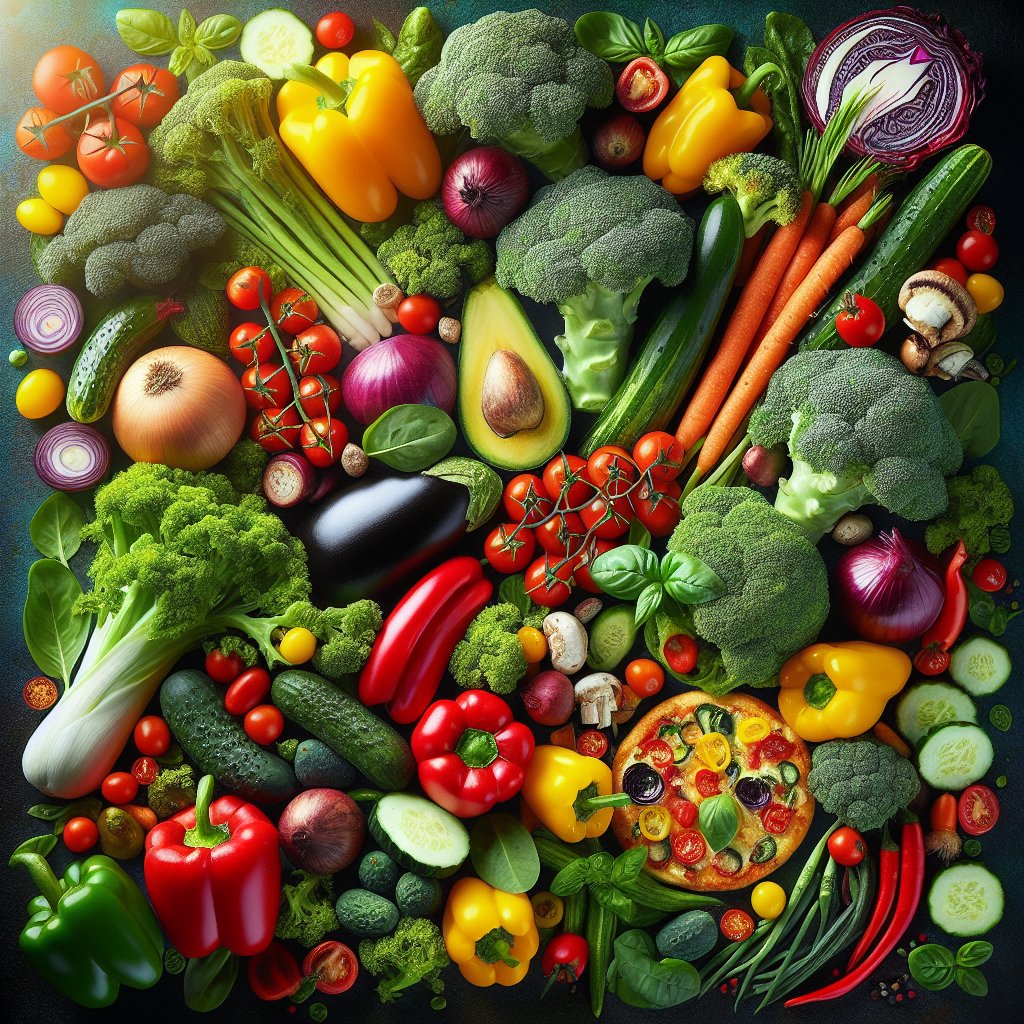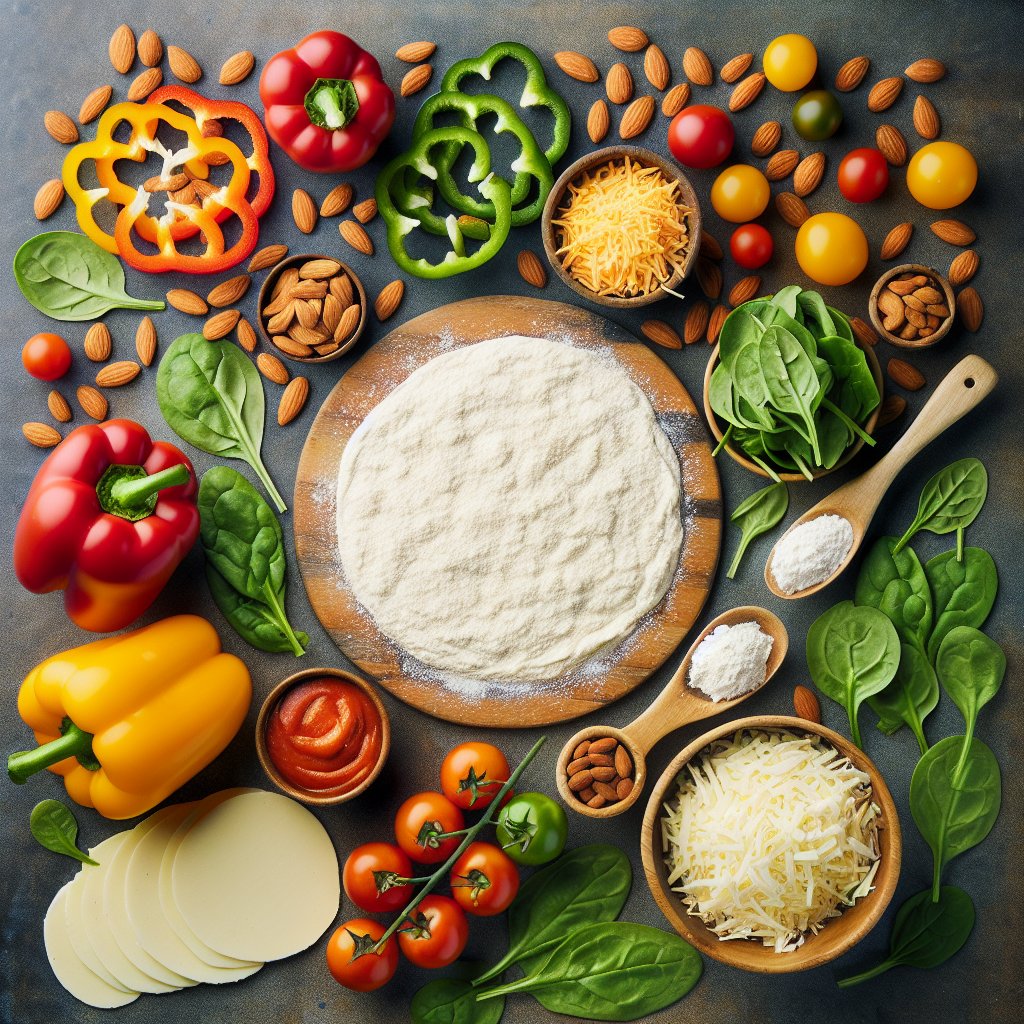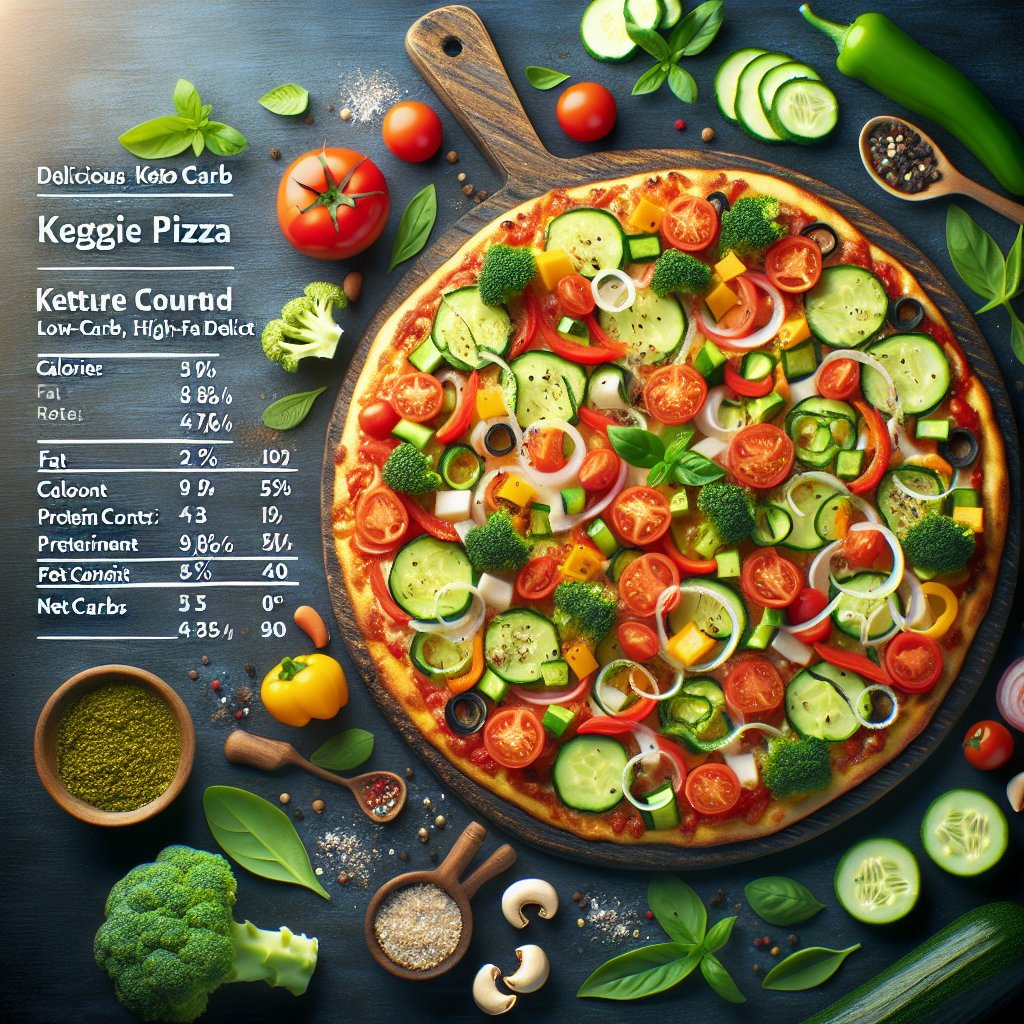Delicious Keto Veggie Pizza Recipe: The Ultimate Low-Carb, High-Fat Delight!
Understanding the Keto Diet
Have you heard of the keto diet and wondered what all the buzz is about? The keto diet, short for ketogenic diet, has been gaining popularity for its remarkable benefits. It’s a low-carb, high-fat diet that offers a variety of health advantages. By significantly reducing your carb intake and replacing it with healthy fats, you encourage your body to enter a state called ketosis. This metabolic state prompts your body to burn fat for fuel instead of carbs, leading to potential weight loss and other health benefits.
With the increasing demand for keto-friendly recipes, the world of food has adapted to provide delicious and satisfying options for those following the keto lifestyle. Whether you’re a seasoned keto enthusiast or just exploring the idea of low-carb, high-fat meals, you’re in for a treat. Today, we’re diving into the wonderful world of keto with a delectable and nourishing veggie pizza recipe that will have your taste buds dancing with delight!

Health Benefits of the Keto Diet
Following a ketogenic diet has been proven to offer a myriad of health benefits. From weight loss to improved blood sugar levels and increased energy, the keto lifestyle has gained traction for its positive impact on overall health.
Weight Loss
One of the most well-known benefits of the keto diet is weight loss. Research published in the Journal of Clinical Endocrinology & Metabolism found that individuals on a ketogenic diet experienced greater weight loss compared to those on a low-fat diet. The high-fat and low-carb nature of the keto diet helps the body enter a state of ketosis, where it burns fat for energy instead of carbohydrates, leading to weight loss.
Improved Blood Sugar Levels
For individuals struggling with high blood sugar levels, the keto diet can offer significant benefits. A study in the American Journal of Clinical Nutrition found that a low-carbohydrate diet like keto can lead to improved insulin sensitivity and better blood sugar control, making it a valuable dietary approach for managing conditions like type 2 diabetes.
Increased Energy
Many people report experiencing increased levels of energy and mental clarity when they switch to the keto diet. This can be attributed to the stable blood sugar levels and the body’s efficient utilization of ketones for fuel, as demonstrated in a study published in the Journal of Physiology. The sustained energy levels throughout the day make the keto diet an attractive choice for those looking to overcome fatigue and sluggishness.
Managing Health Conditions
Besides weight management and improved energy, the keto diet has shown promise in managing various health conditions. For instance, research published in the Journal of Neurochemistry suggests that the keto diet may have neuroprotective benefits and could be beneficial for individuals with neurodegenerative disorders like Alzheimer’s disease. Additionally, the diet has been used as an adjunct therapy for some forms of epilepsy, with compelling evidence in the Journal of Epilepsy Research showing significant reductions in seizure frequency for patients following a ketogenic diet plan.

Importance of Vegetables in Keto Diet
When it comes to the ketogenic diet, vegetables play a crucial role in maintaining a balanced and healthy nutritional intake. Despite the emphasis on high-fat and low-carb foods, vegetables should not be overlooked in a keto lifestyle. In fact, incorporating a variety of vegetables into your keto diet can provide essential nutrients, fiber, and antioxidants while being low in carbs, making them an ideal choice for anyone following a keto diet.
Essential Nutrients and Antioxidants
Vegetables are rich in essential nutrients such as vitamins, minerals, and phytonutrients that are vital for overall health. For example, leafy greens like spinach and kale are excellent sources of vitamins A, C, and K, as well as minerals like iron and calcium. Bell peppers are loaded with vitamin C, while broccoli offers a significant amount of folate and vitamin K. These nutrients are essential for supporting the immune system, maintaining healthy skin, and promoting optimal organ function.
Fiber Content
Fiber is another key component found in vegetables, and it plays a significant role in digestion and overall gut health. Consuming an adequate amount of fiber is essential for maintaining regular bowel movements and supporting a healthy gut microbiome. Since most vegetables are low in net carbs, they are an excellent source of fiber for those on a keto diet.
Low in Carbs
The carbohydrate content in most non-starchy vegetables is relatively low, making them a perfect choice for those aiming to minimize their carb intake while following a ketogenic lifestyle. This allows individuals to enjoy a generous portion of vegetables without significantly impacting their daily carb limit.
Incorporating an assortment of vegetables into your keto meal plans not only enhances the nutritional value of your diet but also adds color, flavor, and texture to your meals. From vibrant salads to hearty stir-fries, the versatility of vegetables makes them an essential and delightful component of any keto diet.
By emphasizing the importance of including a variety of vegetables in a keto diet, individuals can reap the nutritional benefits while staying true to their low-carb, high-fat nutritional goals.
By incorporating a diverse assortment of vegetables into a keto meal plan, individuals can achieve optimal health and nutrition while enjoying a wide range of tasty and satisfying dishes. With their rich nutrient content, low-carb nature, and culinary versatility, vegetables are truly a star ingredient in the world of ketogenic living.

List of Key Ingredients for Keto Veggie Pizza
When it comes to crafting a mouthwatering keto veggie pizza, the secret lies in the ingredients. Let’s dive into the essential components that will make your low-carb pizza a tantalizing delight for your taste buds.
Almond Flour
First and foremost, the crust of your keto veggie pizza will be crafted from almond flour. Almond flour is not only low in carbs but also high in healthy fats, making it an ideal choice for the ketogenic diet. It imparts a delightful nutty flavor to the crust, elevating the entire pizza experience.
Low-Carb Pizza Sauce
No pizza is complete without a generous layer of savory tomato sauce. For a keto-friendly option, opt for a low-carb pizza sauce that is free from added sugars and high-carb ingredients. This ensures that your pizza remains in line with your low-carb, high-fat dietary goals.
Shredded Mozzarella Cheese
Next, the gooey, stretchy goodness of shredded mozzarella cheese is a must-have for any pizza. This rich and creamy cheese not only adds a decadent texture to your keto veggie pizza but also contributes to the fat content, making it a perfect fit for your ketogenic lifestyle.
Fresh Vegetables
As for the toppings, load up your keto veggie pizza with a vibrant array of fresh vegetables. Bell peppers bring a pop of color and crunch, while nutrient-dense spinach adds a dose of green goodness. Cherry tomatoes, bursting with juiciness, provide a refreshing burst of flavor with every bite.

Step-By-Step Recipe Instructions
Are you ready to embark on a keto culinary adventure with a delicious veggie pizza? Say goodbye to the carb-heavy crusts and hello to a low-carb, high-fat delight! Let’s dive into the step-by-step guide on how to prepare a mouthwatering keto veggie pizza that will satisfy your pizza cravings while keeping you in ketosis.
Low-Carb Pizza Crust
First things first – we need to prepare the foundation of our pizza, the low-carb crust. Here’s a simple recipe to make a perfect keto-friendly crust:
- Start by preheating your oven to 425°F (220°C).
- In a bowl, combine 1 and 1/2 cups of shredded mozzarella cheese, 2 tablespoons of cream cheese, 3/4 cup almond flour, 1 egg, and a pinch of salt.
- Microwave the mixture for 1 minute, then stir and microwave for an additional 30 seconds.
- This will form a dough that you can spread onto a parchment-lined baking sheet. Use your hands to shape it into a circle or rectangle, depending on your preference.
- Poke the crust with a fork to prevent bubbling and bake for 10-12 minutes until golden and firm.
Spreading the Sauce and Adding Toppings
Once your crust is baked to perfection, it’s time to add the sauce and toppings:
- Spread a thin layer of sugar-free marinara sauce or pizza sauce over the crust.
- Sprinkle a generous amount of shredded mozzarella cheese over the sauce.
- Now, it’s time to load up on your favorite keto-friendly veggies. Think colorful bell peppers, sliced onions, spinach, mushrooms, olives, and artichoke hearts.
Baking Until Crispy
Pop your veggie-loaded keto pizza back into the oven and bake for an additional 8-10 minutes, or until the cheese is bubbly and the veggies are tender. Keep an eye on it to ensure the crust doesn’t burn.
Finally, remove the pizza from the oven, let it cool for a few minutes, then slice it up and savor every low-carb, high-fat bite!
Remember, the key to the perfect keto pizza crust is in the baking. Keep an eye on it to achieve that ideal crispy yet chewy texture. Now, get ready to indulge in a guilt-free pizza experience!

Nutritional Information
Let’s get into the nitty-gritty of the nutritional breakdown of this delectable keto veggie pizza. When following a ketogenic diet, it’s crucial to be mindful of the macronutrient profile of the foods we consume. This pizza not only satisfies your cravings but also fits perfectly into your low-carb, high-fat lifestyle.
Here’s a sneak peek into the macronutrient profile per serving:
– Calories: The keto veggie pizza recipe packs a punch of flavor with approximately 250-300 calories per serving, making it a satisfying and fulfilling meal without going overboard on your calorie intake.
-
Fat Content: With a generous amount of healthy fats from ingredients like mozzarella cheese and olive oil, this pizza offers around 20-25 grams of fat per serving. These fats are essential for maintaining ketosis and keeping you satiated for longer periods.
-
Protein Content: Each serving of this keto veggie pizza provides about 10-15 grams of protein, contributing to muscle maintenance and overall body functions. The protein content comes from toppings such as spinach, mushrooms, and cheese.
-
Net Carbs: The real hero of this recipe is its net carb content, which typically ranges from 4-6 grams per slice. The low-carb almond flour crust and fiber-rich vegetable toppings ensure that you stay within your carb limits while relishing every bite of this pizza.
With its balanced macronutrient composition, this keto veggie pizza offers a perfect combination of low-carb, high-fat, and moderate protein to support your ketogenic lifestyle. Whether you’re hosting a keto-friendly party or simply treating yourself to a guilt-free indulgence, this pizza is a winner all the way!

Variations and Substitutions for Your Keto Veggie Pizza
One of the best things about making a keto veggie pizza is the sheer versatility of this dish. There are countless ways to customize the toppings and make substitutions to suit your individual preferences or dietary restrictions. Let’s explore some delicious options for creating a personalized keto veggie pizza.
Customizing the Toppings
When it comes to toppings, the sky’s the limit! You can load your keto veggie pizza with a variety of low-carb vegetables such as bell peppers, mushrooms, spinach, onions, cherry tomatoes, zucchini, and olives. These veggies not only add a burst of flavor but also provide essential nutrients and fiber.
If you’re a fan of a heartier pizza, you can incorporate protein-rich ingredients such as grilled chicken, turkey, or even bacon. These additions can take your keto veggie pizza to the next level while keeping it low in carbohydrates.
Dairy-Free or Vegan Options
For those following a dairy-free or vegan keto lifestyle, there are plenty of alternatives to traditional cheese. You can use dairy-free cheese products made from ingredients like almond milk, cashews, or coconut milk. These substitutes melt beautifully and offer a luscious texture similar to regular cheese.
Another fantastic dairy-free option is to create a flavorful pizza sauce using ingredients like pureed tomatoes, garlic, and Italian seasoning. This homemade sauce will add a burst of fresh flavors to your keto veggie pizza.
Crust Alternatives
If you’re looking to switch up the base of your keto veggie pizza, consider using a cauliflower crust or a crust made from almond flour or coconut flour. These alternative crusts are not only low in carbs but also gluten-free, making them suitable for individuals with gluten sensitivities or those following a gluten-free keto diet.
By experimenting with different crusts, toppings, and dairy-free options, you can create a keto veggie pizza that perfectly aligns with your dietary needs and taste preferences. Don’t be afraid to get creative and have fun with your keto-friendly pizza creations!

Tips for Success
Making and enjoying a delicious keto veggie pizza can be a delightful experience, especially when you have a few helpful tips and tricks up your sleeve. Here are some practical ideas to ensure your keto veggie pizza turns out perfectly every time:
Prep Your Veggies in Advance
One of the keys to a successful keto veggie pizza is to have your vegetables prepped and ready to go. Take some time at the beginning of the week to chop, slice, and dice your favorite low-carb veggies such as bell peppers, onions, mushrooms, and spinach. Store them in airtight containers in the fridge for easy access when you’re ready to make your pizza. This simple step can save you time and make the pizza-making process more enjoyable.
Use Parchment Paper for Easy Clean-Up
No one enjoys scrubbing stuck-on cheese and sauce off of baking sheets. To avoid this hassle, line your baking tray with parchment paper before placing your pizza dough and toppings. Not only does this make clean-up a breeze, but it also helps prevent the crust from sticking to the pan, resulting in a perfectly cooked keto veggie pizza every time.
Experiment with Different Flavor Combinations
Don’t be afraid to get creative with your keto veggie pizza! Experimenting with different vegetable combinations and seasonings can take your pizza to the next level. Try adding roasted garlic for a depth of flavor, or sprinkle some red pepper flakes for a subtle kick. The possibilities are endless, so have fun and tailor your pizza to your personal taste preferences.
By prepping your veggies in advance, using parchment paper for easy clean-up, and experimenting with different flavor combinations, you can elevate your keto veggie pizza game and enjoy a delicious low-carb meal that satisfies your cravings without derailing your ketogenic lifestyle.

Conclusion: Incorporating Keto Veggie Pizza Into Your Meal Plan
Now that we’ve explored the wonderful world of keto veggie pizza, it’s clear that this is a dish worth incorporating into your low-carb lifestyle. Not only is it easy to make, but it’s also incredibly delicious and versatile. By choosing a variety of fresh, nutrient-dense vegetables and high-quality, keto-friendly ingredients, you can treat yourself to a satisfying pizza without derailing your health goals.
So, let’s summarize the key points of this article and emphasize the ease and deliciousness of making keto veggie pizza at home.
Summarizing the Key Points
First and foremost, we highlighted the benefits of a ketogenic diet, backed by scientific research. The low-carb, high-fat approach of keto is well-documented in assisting weight loss, managing blood sugar levels, and even supporting mental clarity. It’s not just a diet; it’s a lifestyle that many have found to be effective and sustainable.
We then delved into the importance of incorporating a variety of nutrient-packed vegetables into your meals. From fiber and antioxidants to essential vitamins and minerals, veggies play a crucial role in a well-rounded, healthy diet. By including them in our meals, we not only enhance the flavor and texture but also boost the nutritional value of our food.
Next, we explored the concept of homemade keto veggie pizza as a delightful and satisfying addition to your meal plans. By using a simple yet flavorful cauliflower pizza crust and topping it with vibrant, fiber-rich veggies and creamy, nourishing cheese, you can enjoy a guilt-free indulgence that aligns perfectly with your keto goals.
Emphasizing the Ease and Deliciousness of Making Keto Veggie Pizza at Home
What’s great about homemade keto veggie pizza is that it’s a straightforward and enjoyable process. You have the freedom to customize your toppings based on your preferences and dietary needs. Whether you’re a fan of colorful bell peppers, earthy mushrooms, or zesty cherry tomatoes, there are endless possibilities to create a pizza that suits your taste buds. Plus, the act of assembling and baking your pizza can be a fun and rewarding experience, especially with family and friends.
Furthermore, we can’t ignore the fact that the end result – a scrumptious, veggie-packed pizza – is a meal that satisfies both the palate and the body. By incorporating this healthy and delightful recipe into your keto meal plans, you’re not only treating your taste buds to a delightful experience but also nourishing your body with essential nutrients.
Encouraging Readers to Incorporate Keto Veggie Pizza Into Their Meal Plans
So, to all the keto enthusiasts out there, I encourage you to give this delicious keto veggie pizza a try. It’s a fantastic way to break the monotony of your meal plans and infuse some excitement into your dining experience. With the right ingredients and a bit of creativity, you can relish a guilt-free pizza that’s not just healthy but also incredibly delectable.
Remember, keto living doesn’t have to be dull or restrictive. By embracing recipes like this, you can savor the journey of nourishing your body, delighting your taste buds, and achieving your health and wellness aspirations. Here’s to wholesome, flavorful, and fulfilling keto eating!

References
Benefits of Keto Diet
For more information about the benefits of the keto diet, I recommend checking out the research by Dr. Ethan Weiss and Dr. Priyanka Wali, who are both advocates of the ketogenic lifestyle. Their studies delve into the positive effects of the keto diet on weight management, blood sugar control, and overall health. You can find more details on their research on their respective websites or on reputable health and nutrition websites like Healthline, Medical News Today, and Diet Doctor.
Nutritional Value of Vegetables
If you’re interested in learning about the nutritional value of vegetables and how they fit into the keto diet, I suggest referring to the research and articles by Dr. Sarah Hallberg and Dr. Robert Cywes. Both experts have extensively written about the importance of including nutrient-dense vegetables in a low-carb, high-fat eating plan. You can find valuable insights from their work on their official websites or on well-known nutrition and health platforms such as Harvard Health Publishing, Mayo Clinic, and Nutrition.org.
Keto-Friendly Recipes
For an abundance of keto-friendly recipes, including more delectable options like the Keto Veggie Pizza, I recommend turning to various reliable sources. Websites such as ruled.me, ketodietapp.com, and lowcarbmaven.com offer a wide array of mouthwatering ketogenic recipes, each designed to keep you motivated and satisfied on your low-carb journey. Additionally, renowned cookbooks by keto experts like Martina Slajerova, Leanne Vogel, and Maria Emmerich are treasure troves for anyone seeking innovative and delicious keto-friendly meal ideas.
By exploring these respected sources, you can gain a deeper understanding of the benefits of the keto diet, the nutritional value of vegetables, and countless more keto-friendly recipes to elevate your culinary repertoire while staying true to your low-carb, high-fat lifestyle.

Delicious Keto Veggie Pizza Recipe: The Ultimate Low-Carb, High-Fat Delight!
Servings: 4
Preparation time: 30 minutes
Ingredients:
| 1 head of cauliflower, riced |
| 2 large eggs |
| 1/2 cup grated parmesan cheese |
| 1/2 tsp dried oregano |
| 1/2 tsp garlic powder |
| 1/4 cup almond flour |
| 1/2 cup sugar-free marinara sauce |
| 1 1/2 cups shredded mozzarella cheese |
| Assorted low-carb veggies (bell peppers, mushrooms, spinach, onions, etc.) |
| Fresh basil leaves for garnish |
| Salt and pepper to taste |
Instructions:
| 1. Preheat the oven to 425°F (220°C). Line a baking sheet with parchment paper. |
| 2. In a large bowl, combine the riced cauliflower, eggs, grated parmesan cheese, dried oregano, garlic powder, almond flour, salt, and pepper. Mix well to form a dough-like consistency. |
| 3. Transfer the cauliflower mixture to the prepared baking sheet and shape it into a 10-12 inch round crust, about 1/4 inch thick. Bake for 15-20 minutes or until the crust is golden brown and set. |
| 4. Remove the crust from the oven and spread the sugar-free marinara sauce evenly over the crust. Sprinkle the shredded mozzarella cheese on top. |
| 5. Arrange the assorted low-carb veggies over the cheese, and season with additional salt and pepper if desired. |
| 6. Return the pizza to the oven and bake for another 10-15 minutes, or until the cheese is melted and bubbly, and the veggies are cooked to your liking. |
| 7. Once done, remove the pizza from the oven and let it cool for a few minutes. Garnish with fresh basil leaves. |
| 8. Slice the pizza into wedges and serve hot. Enjoy your delicious keto veggie pizza! |
Nutrition facts:
| Calories per serving | 280 |
| Total fat | 19g |
| Saturated fat | 8g |
| Carbohydrates | 8g |
| Fiber | 3g |
| Protein | 21g |


